The COP28 Climate, Relief, Recovery and Peace Declaration should be seen as a call to change the way development and humanitarian organisations work in fragile and conflict-affected countries – not as a funding opportunity to keep doing more of the same.
Just two years ago, the conversation about scaling up climate action in conflict-affected countries was barely a whisper. At COP26 in Glasgow, ODI hosted the first discussion together with ICRC, the World Bank's FCV Unit, the Adaptation Fund, the FCDO, and the Governments of Niger and Somalia. At COP28 in Dubai, the topic has gone mainstream. 3 December saw the launch of the Declaration on Climate, Relief, Recovery and Peace, on the UNFCC main stage.
The Declaration is as welcome as it is timely. The Declaration calls for “bolder, collective action”to build climate resilience in countries and communities facing heightened vulnerabilities due to fragility and conflict, and is accompanied by a package of solutions that each signatory pledges against the agenda. It has already been endorsed by over 70 states and 40 organisations, including ODI.
This increased focus stems from the international community's recognition that individuals residing in fragile and conflict-affected situations are exceptionally vulnerable to the effects of climate change. This is not by coincidence. These communities are more vulnerable precisely because conflict has undermined the institutions and government support they rely on to anticipate, absorb and adequately adapt to climate shocks. Yet despite this, they also receive some of the least international finance to adapt to climate change, because working in these environments is considered too difficult and risky. Somalia, for instance, which experienced a devastating drought over 2020-2022 followed by large-scale flooding in 2023, receives less than 1% of the funding it needs to adapt to climate change.
The barriers to investing and operating in areas affected by armed conflict, violence and fragile governance are well established. The Declaration outlines several ways to address these barriers and support international efforts to build climate resilience in these countries, focusing on “enhanced financial support”, “improved good practice and programming”, and “strengthened coordination, collaboration and partnerships” to increase the impact of investments and programmes. To fulfil these objectives, the 110+ signatories must contemplate significant changes in their approaches and operations.
Beyond financial contributions
Increasing adaptation finance to these places is important, but it’s not the only issue. Action in other areas is required too. There’s a need to increase the capacity of fragile and conflict-affected states to absorb and effectively use this finance. For instance, Somalia’s 2021 Nationally Determined Contribution (NDC) to the UNFCCC outlines a requirement of USD 5.5 billion annually (equivalent to USD 55.5 billion between 2021 and 2030) in climate finance, yet its GDP in the same year was only USD 7.6 billion. Without building the financial absorptive capacity of governments like Somalia, expecting any country to absorb an additional 75% of its GDP is unrealistic. Additional finance alone will not solve all problems.
Building the capacity of national and especially local authorities takes time – but it cannot be an excuse to bypass them entirely. There is no doubt that working with local authorities in fragile and conflict-affected areas – including, sometimes, non-armed state groups – is challenging: they are often unable or unwilling to partner with the central government and as a result cannot access climate finance. But the humanitarian and development communities cannot continue using these obstacles as an excuse to avoid engaging with these actors. Enhancing the capacity of governments and local authorities is fundamental to address the underlying drivers of people’s climate vulnerability - which in fragile and conflict-affected countries, include poverty, conflict and instability - and exposure to both current climate extremes and future climate risks.
Building forward better
In bypassing state and influential non-state actors to work just with local communities, humanitarians and sometimes development practitioners perpetuate a piecemeal and siloed approach that excessively focuses on the individual or household level. This places the burden of adapting and coping with climate shocks on individuals who cannot be expected to meaningfully achieve systematic climate change adaptation. Instead of merely seeking more funding to sustain their existing activities within this current paradigm, organisations must move away from this fragmented, siloed approach to forge partnerships across areas of expertise. By layering and sequencing their work, and sharing expertise between sectors, these actors can help support efforts to build long-term climate resilience and mitigate the risks of maladaptation.
COP28’s Climate, Relief, Recovery and Peace Declaration, and its associated package of solutions, marks an important first step in building the political willpower to scale up action and finance in fragile and conflict-affected countries. But we must be wary of agencies using the Declaration as an excuse for resource mobilisation, or for governments to rehash old commitments rather than providing new money. We must also ensure that this call to action leads to a real change in the way humanitarians and development actors work, rather than simply funding opportunities to do more of the same.




